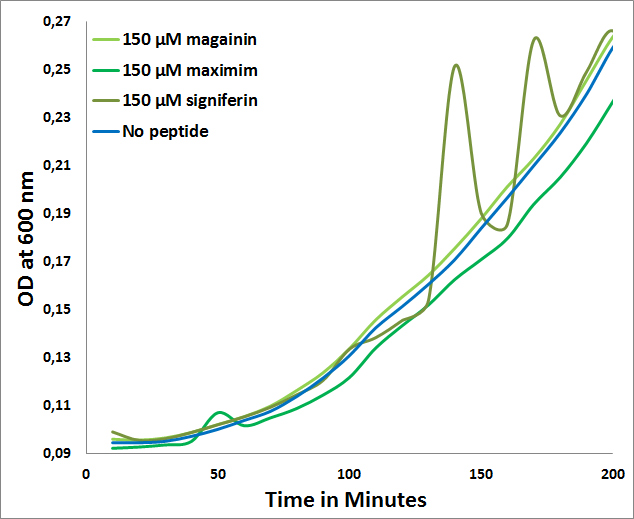Difference between revisions of "Part:BBa K1022112"
| Line 25: | Line 25: | ||
'''Introduction:''' | '''Introduction:''' | ||
| − | An important part of the project TU Delft iGEM13 is inhibition of growth or killing of bacteria with the use of antimicrobial peptides (AMPs). In order to get an idea of the toxicity of our peptides we conducted several minimal inhibiting concentration (MIC) experiments. These MIC measurements where done on ''E. coli'', ''B. subtilis'' and ''S. delphini'', with the first as representative of our Gram-negative expression host, the second for the Gram-positive targets and the last for our specific target. | + | An important part of the project TU Delft iGEM13 is inhibition of growth or killing of bacteria with the use of antimicrobial peptides (AMPs). In order to get an idea of the toxicity of our peptides we conducted several minimal inhibiting concentration (MIC) experiments with synthetic peptides ordered from DNA 2.0. These MIC measurements where done on ''E. coli'', ''B. subtilis'' and ''S. delphini'', with the first as representative of our Gram-negative expression host, the second for the Gram-positive targets and the last for our specific target. |
'''MIC determination:''' | '''MIC determination:''' | ||
Latest revision as of 20:59, 4 October 2013
PT7: RBS: Magainin II: His 6
This biobrick codes for the promoter pT7, Magainin II peptide with a His 6 tag.
Sequence and Features
- 10COMPATIBLE WITH RFC[10]
- 12COMPATIBLE WITH RFC[12]
- 21COMPATIBLE WITH RFC[21]
- 23COMPATIBLE WITH RFC[23]
- 25COMPATIBLE WITH RFC[25]
- 1000COMPATIBLE WITH RFC[1000]
Characterization
For more info, visit [http://2013.igem.org/Team:TU-Delft/PeptideCharacterization TU Delft iGEM13 Wiki]
Information
This part is one of the basic bio bricks used in the project [http://2013.igem.org/Team:TU-Delft/Project Peptidor] by Team TU Delft
Please visit [http://2013.igem.org/Team:TU-Delft iGEM 2013 Team TU Delft] for more
Peptide Characterization
Introduction:
An important part of the project TU Delft iGEM13 is inhibition of growth or killing of bacteria with the use of antimicrobial peptides (AMPs). In order to get an idea of the toxicity of our peptides we conducted several minimal inhibiting concentration (MIC) experiments with synthetic peptides ordered from DNA 2.0. These MIC measurements where done on E. coli, B. subtilis and S. delphini, with the first as representative of our Gram-negative expression host, the second for the Gram-positive targets and the last for our specific target.
MIC determination:
The MIC of Magainin II on S. delphini, B. subtilis and E. coli were done according to the protocol described [http://2013.igem.org/Team:TU-Delft/PeptideCharacterization here]. Magainin II did not give a measurable reduction in growth below 40µM (Figure 1), making us decide not to proceed testing, as modeling showed it was not possible to reach these concentrations through expression in E.coli.
- Figure 1: MIC of Magainin II on S. delphini
For Other peptides and their characterization please visit [http://2013.igem.org/Team:TU-Delft/PeptideCharacterization Peptide characterization] on TU Delft iGEM13 Wiki
Comparison with two peptides:
The fact that for none of the peptides a MIC could be determined for E. coli (>150µM) further confirms the expected selectivity towards Gram-positives which is observed in the following graph(Figure 2):
- Figure 2: MICs of Maximim-H5, Signiferin and Magainin on E. coli
Peptide Production
For more info about the production of the peptide Magainin II, visit [http://2013.igem.org/Team:TU-Delft/Peptides#SUMO Peptide production] on TU Delft iGEM13 Wiki.
Also check the construct used for the peptide production BBa_K1022103 and more characterization.


